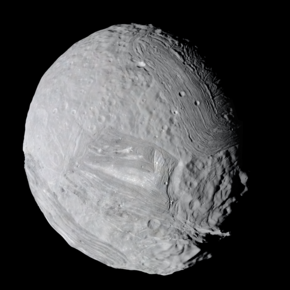
Back Miranda (maan) Afrikaans Miranda (satelite) AN ميراندا (قمر) Arabic Miranda (peyk) Azerbaijani میراندا (قمر) AZB Міранда (спадарожнік Урана) Byelorussian Миранда (спътник) Bulgarian Miranda (mjesec) BS Miranda (satèl·lit) Catalan Miranda (ôi-sĭng) CDO
You can help expand this article with text translated from the corresponding article in French. (February 2023) Click [show] for important translation instructions.
|
 Assembled mosaic of Miranda using imagery from Voyager 2, January 1986. Large coronae scar Miranda's varied surface, with the bright angular corona at center being Inverness Corona | |||||||||
| Discovery | |||||||||
|---|---|---|---|---|---|---|---|---|---|
| Discovered by | Gerard P. Kuiper | ||||||||
| Discovery date | February 16, 1948 | ||||||||
| Designations | |||||||||
Designation | Uranus V | ||||||||
| Pronunciation | /məˈrændə/[1] | ||||||||
| Adjectives | Mirandan,[2] Mirandian[3] | ||||||||
| Orbital characteristics | |||||||||
| 129390 km | |||||||||
| Eccentricity | 0.0013 | ||||||||
| 1.413479 d | |||||||||
Average orbital speed | 6.66 km/s (calculated) | ||||||||
| Inclination | 4.232° (to Uranus's equator) | ||||||||
| Satellite of | Uranus | ||||||||
| Physical characteristics | |||||||||
| Dimensions | 480 km × 468.4 km × 465.8 km | ||||||||
Mean radius | 235.8±0.7 km (0.03697 Earths)[4] | ||||||||
| 698100 km2 | |||||||||
| Volume | 54830000 km3 | ||||||||
| Mass | (6.293±0.300)×1019 kg[6] | ||||||||
Mean density | 1.148 g/cm3 (calculated) | ||||||||
| 0.076 m/s2 | |||||||||
| 0.189 km/s | |||||||||
| synchronous | |||||||||
| 0° | |||||||||
| Albedo | 0.32 | ||||||||
| |||||||||
| 16.6[8] | |||||||||
Miranda, also designated Uranus V, is the smallest and innermost of Uranus's five round satellites. It was discovered by Gerard Kuiper on 16 February 1948 at McDonald Observatory in Texas, and named after Miranda from William Shakespeare's play The Tempest.[9] Like the other large moons of Uranus, Miranda orbits close to its planet's equatorial plane. Because Uranus orbits the Sun on its side, Miranda's orbit is nearly perpendicular to the ecliptic and shares Uranus's extreme seasonal cycle.
At just 470 km in diameter, Miranda is one of the smallest closely observed objects in the Solar System that might be in hydrostatic equilibrium (spherical under its own gravity), and happens to have a surface area roughly similar to Texas. The only close-up images of Miranda are from the Voyager 2 probe, which made observations of Miranda during its Uranus flyby in January 1986. During the flyby, Miranda's southern hemisphere pointed towards the Sun, so only that part was studied.
Miranda probably formed from an accretion disc that surrounded the planet shortly after its formation and, like other large moons, it is likely differentiated, with an inner core of rock surrounded by a mantle of ice. Miranda has one of the most extreme and varied topographies of any object in the Solar System, including Verona Rupes, a roughly 20-kilometer-high scarp that may be the highest cliff in the Solar System,[10][11] and chevron-shaped tectonic features called coronae. The origin and evolution of this varied geology, the most of any Uranian satellite, are still not fully understood, and multiple hypotheses exist regarding Miranda's evolution.
- ^ "Miranda". Oxford English Dictionary (Online ed.). Oxford University Press. (Subscription or participating institution membership required.)
- ^ Journal of Geophysical Research, v. 93 (1988)
- ^ Robertson (1929), The life of Miranda'
- ^ Thomas 1988.
- ^ French et al. 2024.
- ^ Jacobson (2023), as cited in French et al. (2024)[5]
- ^ Hanel Conrath et al. 1986.
- ^ Scobel 2005.
- ^ Kuiper 1949.
- ^ Chaikin, Andrew (2001-10-16). "Birth of Uranus' provocative moon still puzzles scientists". space.com. Imaginova Corp. p. 2. Retrieved 2007-07-23.
- ^ "APOD: 2016 November 27 - Verona Rupes: Tallest Known Cliff in the Solar System". apod.nasa.gov. Retrieved 2018-02-20.
© MMXXIII Rich X Search. We shall prevail. All rights reserved. Rich X Search